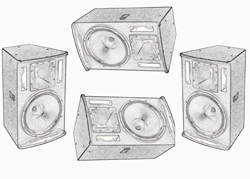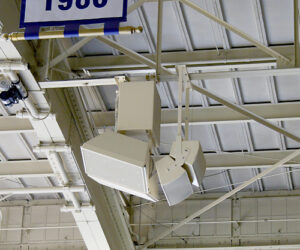For decades, compact 2-way loudspeakers have been a pillar of professional audio, capable of serving as mains, monitors, side fills, center fills, near fills, front fills and delays.
Usually they can be carried by a single person via convenient handles and quickly ground stacked, flown, or placed on a stand, where they’re capable of handling reinforcement all by themselves or joined by subwoofers in applications requiring additional low-end reinforcement.
Many of these boxes are trapezoidal in shape, with some able to be put into tightly packed horizontal arrays and others better suited for “exploded” clusters. Still others can be stacked or flown into line and/or column arrays.
Several offer a modified cabinet shape that also allows them to be placed on their side and used as floor monitors. And speaking of cabinets, they’re constructed of ABS/polymers/plastics as well as wood.
Increasingly, compact 2-way loudspeakers are offered in self-powered versions (usually Class D amplification) joined by digital signal processing. Many are also outfitted with facilities for further tailoring output to the specific application, as well as flexible I/O capabilities for additional cabinets and subwoofers in a variety of configurations.
Smaller models incorporate single 8- or 10-inch woofers, with the more popular models offering 12- or 15-inch woofers for additional low-end performance. Usually the woofers are accompanied by a compression driver on a horn or waveguide, although ribbon drivers have also emerged as a viable option from certain companies. Let’s also not overlook coaxial models where the individual driver units radiate sound from the same point/ axis, which, when designed properly, can enhance coherence.
When evaluating compact 2-way loudspeakers, start by defining the right box for the job – size, scale, mounting, portability, and so on. It all depends on the requirements of the application(s). Our tour of recent models that follows is intended, by design, to present the “state of the market” in terms of options. But for each type of model presented here, understand that there are several similar models from the same and other sources, so further homework is strongly recommended.
When making “apples to apples” comparisons, here are basic factors to consider:
❚ Dispersion, a measurement of the pattern of MF/HF sound that emanates from the box, stated in degrees for the horizontal and vertical planes.
❚ Power Handling, which is usually stated as an “RMS ” or “continuous” rating in watts.
❚ Sensitivity, stated in decibels, is a measurement of the sound level the loudspeaker can produce with a given input signal, generally measured with 1 watt input at 1 meter distance. (By the way, we’re seeing an increasing number of manufacturers who prefer to provide a Maximum SPL specification.)
❚ Mounting, which includes integrated rigging flypoints as well as things like pole cups that can come in quite handy for true portable applications.
Whether placed on a stand for a speech at a grand opening ceremony, stacked on top of subwoofers at the local music venue, or hung from the ballroom ceiling at a corporate event, the ubiquitous compact 2-way box gets the job done.
Take our Photo Gallery Tour of recent 2-way loudspeakers on the market.
















